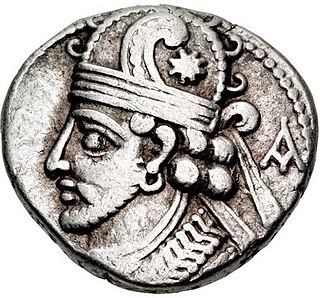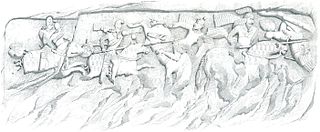
Arsaces I was the first king of Parthia, ruling from 247 BC to 217 BC, as well as the founder and eponym of the Arsacid dynasty of Parthia. The leader of the Parni, one of the three tribes of the Dahae confederacy, Arsaces founded his dynasty in the mid-3rd century BC when he conquered the satrapy of Parthia from Andragoras, who had rebelled against the Seleucid Empire. He spent the rest of his reign consolidating his rule in the region, and successfully stopped the Seleucid efforts to reconquer Parthia. Due to Arsaces' achievements, he became a popular figure amongst the Arsacid monarchs, who used his name as a royal honorific. By the time of his death, Arsaces had laid the foundations of a strong state, which would eventually transform into an empire under his great-grandnephew, Mithridates I, who assumed the ancient Near Eastern royal title of King of Kings. Arsaces was succeeded by his son Arsaces II.

Mithridates I, also known as Mithridates I the Great, was king of the Parthian Empire from 165 BC to 132 BC. During his reign, Parthia was transformed from a small kingdom into a major political power in the Ancient East as a result of his conquests. He first conquered Aria, Margiana and western Bactria from the Greco-Bactrians sometime in 163–155 BC, and then waged war with the Seleucid Empire, conquering Media and Atropatene in 148/7 BC. In 141 BC, he conquered Babylonia and held an official investiture ceremony in Seleucia. The kingdoms of Elymais and Characene shortly afterwards became Parthian vassals. In c. 140 BC, while Mithridates was fighting the nomadic Saka in the east, the Seleucid king Demetrius II Nicator attempted to regain the lost territories; initially successful, he was defeated and captured in 138 BC, and shortly afterwards sent to one of Mithridates I's palaces in Hyrcania. Mithridates I then punished Elymais for aiding Demetrius, and made Persis a Parthian vassal.

Phraates IV was King of Kings of the Parthian Empire from 37 to 2 BC. He was the son and successor of Orodes II, and was given the throne after the death of his brother Pacorus I. Phraates IV soon murdered all his brothers, and also possibly his father. His actions alienated the Armenians and also some of his nobles, including the distinguished Monaeses, who fled to the Roman triumvir Mark Antony, but shortly returned and reconciled with Phraates IV.

Phraates V, also known by the diminutive version of his name, Phraataces, was the King of Kings of the Parthian Empire from 2 BC to 4 AD. He was the younger son of Phraates IV and Musa, who ruled with him.

Artabanus I, incorrectly known in older scholarship as Artabanus II, was king of the Parthian Empire, ruling briefly from c. 127 to 124/3 BC. His short reign ended abruptly when he died during a battle against the Yuezhi in the east. He was succeeded by his son Mithridates II.

Artabanus IV, also known as Ardavan IV (Parthian:𐭓𐭕𐭐𐭍), incorrectly known in older scholarship as Artabanus V, was the last ruler of the Parthian Empire from c. 213 to 224. He was the younger son of Vologases V, who died in 208.

Vonones I was an Arsacid prince, who ruled as King of Kings of Parthian Empire from 8 to 12, and subsequently as king of Armenia from 12 to 18. He was the eldest son of Phraates IV and was sent to Rome as a hostage in 10/9 BC in order to prevent conflict over the succession of Phraates IV's youngest son, Phraataces.

Pacorus II was the King of Kings of the Parthian Empire from 78 to 110. He was the son and successor of Vologases I.

Arsaces II, was the Arsacid king of Parthia from 217 BC to 191 BC.

Priapatius, was the Arsacid king of Parthia from 191 BC to 176 BC. He was the first-cousin-once-removed and successor of Arsaces II. Like many Arsacid monarchs, his reign is sparsely known. His coinage indicates that he managed to rid himself of the influence of the Seleucid Empire. He was succeeded by his son Phraates I.

Vologases III was king of the Parthian Empire from 110 to 147. He was the son and successor of Pacorus II.

Osroes I was a Parthian contender, who ruled the western portion of the Parthian Empire from 109 to 129, with a one-year interruption. For most of his reign he contended with the rival king Vologases III who was based in the eastern provinces. In 116, Osroes I was briefly ousted from his throne at Ctesiphon during an invasion by Roman emperor Trajan, who installed Osroes' son, Parthamaspates. After Trajan's death the following year, Osroes I's rule was reinstated by the Parthian nobility. In 129, he was removed from power by Vologases III.

Vologases IV was King of Kings of the Parthian Empire from 147 to 191. He was the son of Mithridates V. Vologases spent the early years of his reign re-asserting Parthian control over the Kingdom of Characene. From 161 to 166, he waged war against the Roman Empire; although initially successful, conquering Armenia and Syria, he was eventually pushed back, briefly losing control of the Parthian capitals of Seleucia and Ctesiphon to the Romans. The Romans suffered heavy losses from a plague erupting from Seleucia in 166, forcing them to withdraw. The war ended soon afterward, with Vologases losing most of northern Mesopotamia to the Romans. He died in 191 and was succeeded by his son Vologases V.

Vologases V was King of Kings of the Parthian Empire from 191 to 208. As king of Armenia, he is known as Vologases II. Not much is known about his period of kingship of Armenia, except that he put his son Rev I on the Iberian throne in 189. Vologases succeeded his father Vologases IV as king of the Parthian Empire in 191; it is uncertain if the transition of power was peaceful or if Vologases took the throne in a civil war. When Vologases acceded the Parthian throne, he passed the Armenian throne to his son Khosrov I.

Musa, also known as Thea Musa, was a ruling queen of the Parthian Empire from 2 BC to 4 AD. Originally an Italian slave-girl, she was given as a gift to the Parthian monarch Phraates IV by the Roman Emperor Augustus. She quickly became queen and a favourite of Phraates IV, giving birth to Phraataces. In 2 BC, she had Phraates IV poisoned and made herself, along with Phraates V, the co-rulers of the empire. Their reign was short-lived; they were forced to flee to Rome after being deposed by the Parthian nobility, who crowned Orodes III as king.

Andragoras was an Iranian satrap of the Seleucid provinces of Parthia and Hyrcania under the Seleucid rulers Antiochus I Soter and Antiochus II Theos. He later revolted against his overlords, ruling independently from 245 BC till his death.

The Battle of Hormozdgan was the climactic battle between the Arsacid and the Sasanian dynasties that took place on 28 April 224. The Sasanian victory broke the power of the Parthian dynasty, effectively ending almost five centuries of Parthian rule in Iran, and marking the official start of the Sasanian era.

Kamnaskires II, surnamed Nikephoros was a king of the Elymais only known from his coins. He reigned from about 147 to 139 BC. Around 150 BC, the Seleucid empire disintegrated and at several places local governors became independent and assumed the title of "king" (basileus). The first king in the Elymais was Kamnaskires Soter, who ruled around 147 BC. Kamnaskires II Nikephoros ruled slightly later and it is possible that he was identical with Kamnaskires Soter, just changing his name. In 140 BC, Kamnaskires II accepted Parthian suzerainty. However, not long after, Kamnaskires II aided the Seleucid ruler Demetrius II Nicator against the Parthian monarch Mithridates I. However, Demetrius was eventually defeated and captured by the Parthians. Mithridates I then punished Elymais for aiding the Seleucids–he invaded the region once more and captured two of their major cities.
Phraates was a Parthian prince, who was one of the eldest sons of Phraates IV.

















